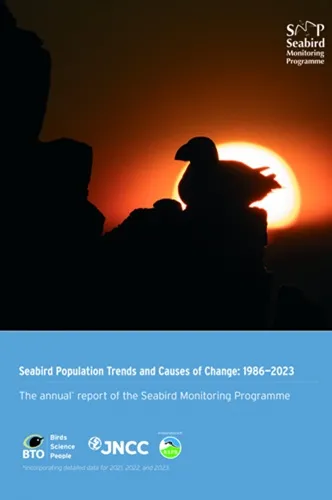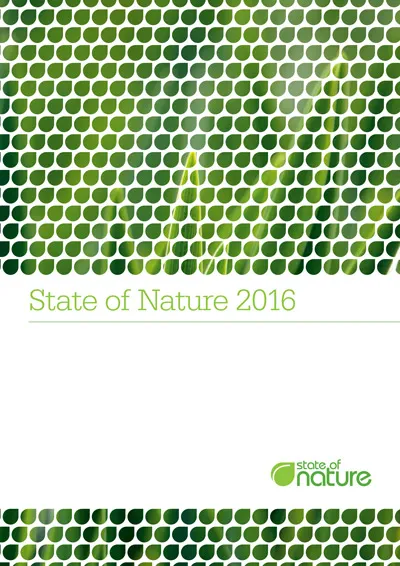BTO create and publish a variety of important articles, papers, journals and other publications, independently and with our partners, for organisations, government and the private sector. Some of our publications (books, guides and atlases) are also available to buy in our online shop.
Annual report of the Seabird Monitoring Programme
Seabird Population Trends and Causes of Change: 1986–2023
This report presents the latest seabird population trends in breeding abundance and productivity using data from the Seabird Monitoring Programme (SMP).
The report documents changes in the abundance and productivity of breeding seabird species in Britain and Ireland from 1986 to 2023, and provides a detailed account of the 2021, 2022 and 2023 breeding seasons.

Search settings
Updated risk of H5N1 HPAI incursion to poultry in Great Britain via wild birds
Author: Kosmider, R., Smith, J., Gillings, S., Snow, L., Breed, A.C., Irvine, R.M. & Hill, A.
Published: 2016
16.09.16
Papers
State of Nature report 2016
Author:
Published: 2016
The State of Nature report is an assessment of how nature is doing across the UK. As well as an overarching assessment of UK flora and fauna, there are separate reports for England, Scotland, Northern Ireland and Wales to look at each country in more depth. The reports pool data and expertise from 53 nature conservation and research organisations, a partnership unparalleled in UK conservation.The BTO is proud to be a founding member of the State of Nature Partnership and our long-term volunteer-based monitoring schemes are key to such assessments. It is extremely important that well-structured monitoring to track changes in biodiversity continues and that good evidence is collected to identify the causes of change. Publicising the results and engagement with the public as well as policy-makers is essential to the success of any project based on citizen science.
14.09.16
Reports State of Nature

Human activities and biodiversity opportunities in pre‐industrial cultural landscapes: relevance to conservation
Author: Fuller, R.J., Williamson, T., Barnes, G. & Dolman, P.M.
Published: 2016
1.Conservation practices in Europe frequently attempt to perpetuate or mimic the ‘tradi-tional’ forms of management of semi-natural habitats, but with a limited understanding of what these entailed.2.We review the emerging understanding of ecological processes, structures and management interventions that enhance biodiversity (wildlife) at diverse scales. These are then examined in the context of pre-industrial (c. 1200–1750) land management systems in lowland England, in order to identify historic practices which are likely to have provided important wildlife resources, but which are relatively neglected in current conservation management.3.Principles enhancing alpha and beta diversity and the conservation status of threatened species include structural complexity and heterogeneity at nested spatial scales; physical disturbance and exposure of mineral substrate; nutrient removal; lengthened successional rotations; and spatial variation in grazing regimes.4.The available evidence suggests that pre-industrial land management was generally characterized by intense resource exploitation and significant levels of biomass harvest; complex nested structural heterogeneity both between and within landscape elements; overlaying of multiple land uses; and spatial and temporal variability in management, rendering the concept of long-lived ‘traditional’ practice problematic. Grazing patterns are poorly understood, but intensive grazing was probably the norm in most contexts, potentially resulting in simplified sward structures and suppressed ecotonal vegetation.5.In much of the pre-industrial period, early-successional and disturbed microhabitats were widespread, but ungrazed or lightly grazed herb-rich vegetation may have been limited, the converse of current conservation management. The key change since then has been homogenization at multiple scales, coupled with reduction of specific niches and conditions.6.Synthesis and applications.In adopting perceived ‘traditional’ management practices, mod-ern conservation rarely achieves the range and complexity of conditions that were present in the past. A better understanding of past practices allows more favourable management of those surviving semi-natural habitats where historic assemblages persist–with greater emphasis on physical disturbance and variability in prescriptions both temporally and spatially.When creating or restoring habitats, after interruption of management sufficiently long for dependent assemblages to be lost, better appreciation of historic management encourages novel forms of intervention to enhance biodiversity, with emphasis on complex structural and spatial heterogeneity at nested scales, biomass removal and nutrient reduction. These strongly management-based approaches are complementary to the use of large herbivores to create and maintain dynamic ecotonal mosaics in the manner advocated by some proponents of ‘rewilding’.
12.09.16
Papers
Management responses to ash dieback (Hymenoscyphus fraxineus) in woodland: implications for woodland structure and resources for biodiversity
Author: Robert J. Fuller
Published: 2016
This report addresses the question of how responses by woodland managers to the dieback of ash (Fraxineus excelsior) caused by the fungal pathogen Hymenoscyphus fraxineus coud alter the opportunities for woodland wildlife in Britian.
21.08.16
Reports
Bird Photographer of the Year 2016
Author:
Published: 2016
This wonderful book includes a selection of the most stunning images from the winners and short-listed photographers who took part in the Bird Photographer of the Year award 2016.
20.08.16
Books and guides